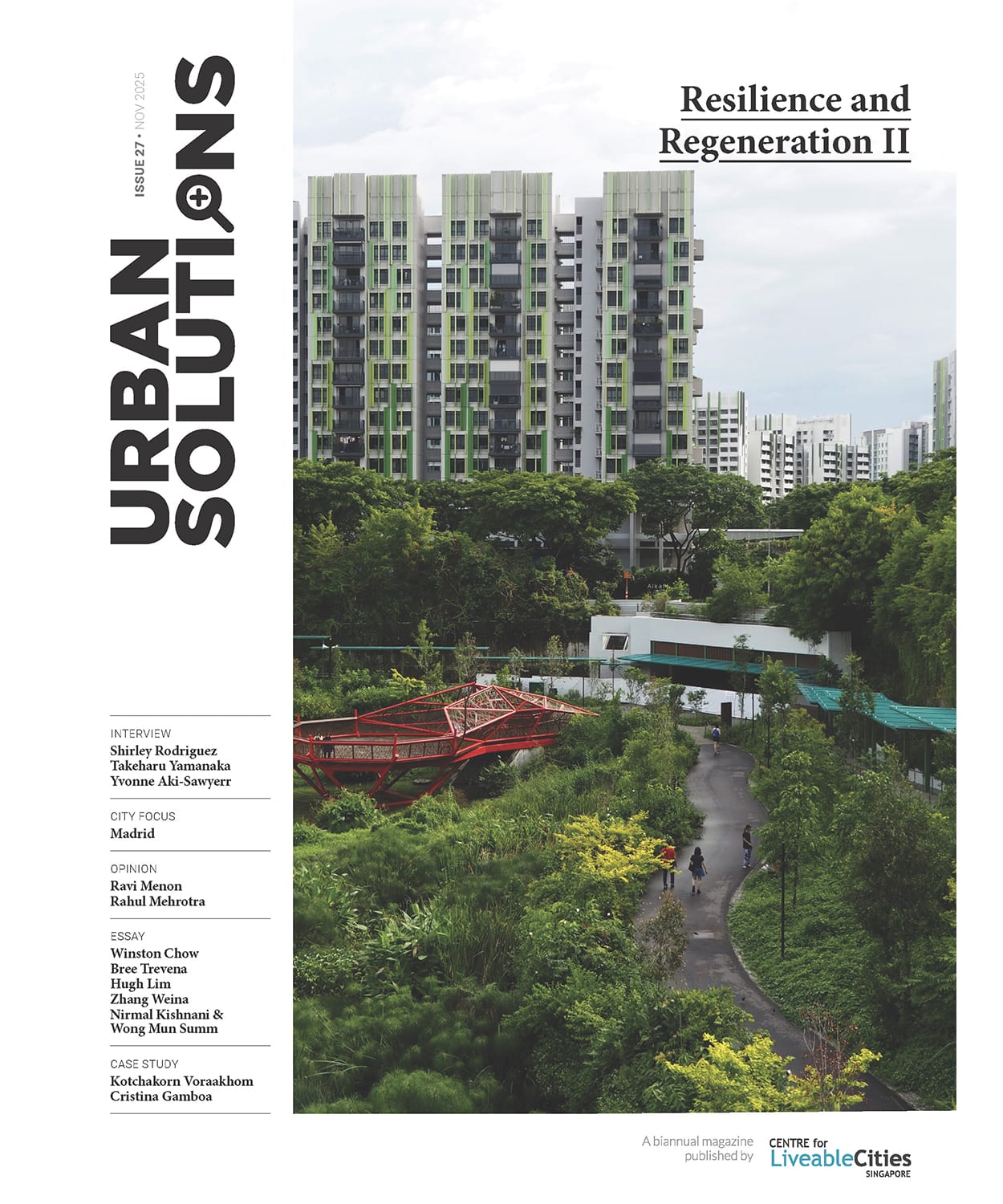Issue 27: Resilience and Regeneration II
Issue 27 aims to reflect on the opportunities and challenges of operationalising regenerative design, unpacking enablers that drive integration, and outcomes that build resilience. It builds upon Issue 25, which explores the concept of regenerative design.

In this Issue
All articles are in pdf format each ranging 1-2 MB in file size.
Interview
ADVANCING CLIMATE ACTION THROUGH GLOBAL AND LOCAL POLICIES [PDF, 913KB]
SHIRLEY RODRIGUES
YOKOHAMA LEADING THE GLOBAL SHIFT TO A CIRCULAR ECONOMY [927 KB]
TAKEHARU YAMANAKA
FREETOWN’S INNOVATIVE AND COLLABORATIVE CLIMATE AGENDA [PDF, 1.10 MB]
YVONNE AKI-SAWYERR
City Focus
RETURNING LIFE TO THE CITY: RENATURALISING THE MANZANARES RIVER [PDF, 2.81 MB]
MADRID
Opinion
CLIMATE RESILIENCETHROUGH REGENERATION [PDF, 472 KB]
RAVI MENON
TEMPORALITY AS A STRATEGY FOR RESILIENT AND REGENERATIVE CITIES [PDF, 765 KB]
RAHUL MEHROTRA
Essay
RESILIENT AND REGENERATIVE CITIES FOR A CLIMATE-CHANGED WORLD [PDF, 1.09 MB]
WINSTON CHOW, ELAINE TAN & ANDY TAN
CHARTING REGENERATIVE URBAN FUTURES: A WORKING REGENERATIVE CITY FRAMEWORK [PDF, 2.61 MB]
HUGH LIM & ALYSIA WEE
REGENERATIVE DESIGN: ACROSS URBAN SCALES [PDF, 1.13 MB]
BREE TREVENA
SYSTEMS, PATTERNS, PLACE: A NOVEL FRAMEWORK FOR URBAN TRANSFORMATIONS [PDF, 1.23 MB]
NIRMAL KISHNANI & WONG MUN SUMM
RETHINKING VALUE CREATION IN BUILDING SUSTAINABLE AND REGENERATIVE CITIES [PDF, 1.23 MB]
ZHANG WEINA, FANNY XUEQI OR, ZHANG FEIMO & JEFFERSON
Case Study
REGENERATING NATURE, TRANSFORMING GOVERNANCE: REDEVELOPING THAILAND’S GOVERNMENT COMPLEX [PDF, 3.04 MB]
BANGKOK | SOCIAL AND ECOLOGICAL SYSTEMS
CIRCULAR CITIES: REGENERATIVE PRACTICES FOR A RESILIENT URBAN FUTURE [PDF, 2.76 MB]
GLOBAL | REGENERATIVE STRATEGIES IN ACTION
Download PDF [PDF, 19.2 MB]
Message from the Executive Director
A New Paradigm for Resilience: Regenerative Cities Regenerative Cities
With temperatures on the rise, more cities are trying to keep cool whilst adhering to net zero targets. Cities are also needing to house more people, amid greater resource constraints. Urban solutions need to address these intertwined issues, mitigating environmentally harmful activities as we build resilience against short-term shocks and long-term stressors.
The concept of regenerative cities proposes that urban development should lead to restorative relationships with nature, because it is from nature that the city draws resources. In this issue, I share CLC’s working framework for regenerative cities, applying it across case studies from Singapore, London, and Bangkok.
The 27th issue, Resilience and Regeneration II, is a sequel to the 25th issue, where we started exploring how cities are building climate resilience in the face of multiple urban challenges. We continue that discussion by distilling regenerative cities into three key dimensions.
Systems thinking—Relationships across scale and disciplines
Shirley Rodrigues, former Deputy Mayor of London, shares the need for city governments to work with national and global governments to accelerate innovative policies for climate action. Ravi Menon, Singapore’s Ambassador for Climate Action, underscores the need for regional coordination to build systemic resilience in the face of transboundary risks.
At the city-level, systems thinking acknowledges the interconnected nature of cities. Nirmal Kishnani and Wong Mun Summ, co-programme directors of MSc Integrated Sustainable Design at the National University of Singapore (NUS), posit that planning begins with analysing the exchanges and flows across urban systems.
Temporality—Harness circular flows through long-term planning
Time as a dimension suggests the need for a whole-of-lifecycle approach to harness circular flows. To enable this, Mayor Takeharu Yamanaka shares how the City of Yokohama embeds circularity principles into governance, effecting change from individual households to partnerships between cities.
Similarly, Rahul Mehrotra, the founder principal of RMA Architects, encourages us to think about transitional design, underpinned by the concept of a kinetic city.
People and the Environment—Interdependencies and mutual importance of social and ecological systems
Freetown, as Mayor Yvonne Aki-Sawyerr elucidates, is a testament to the positive impact of community partnerships and nature-based solutions. In Spain, Juan Azcárate and Antonio Morcillo from the Madrid City Council make a compelling case for how the thriving ecological systems of the Madrid Río enable local communities to flourish.
Likewise, Kotchakorn Voraakhom, founder of Landprocess, outlines how the prioritisation of human connectivity and biodiversity at Bangkok’s Thailand Government Complex brought about inviting spaces for enhancing human-nature relationships.
I hope this issue of Urban Solutions will inspire truly resilient and regenerative cities, reconciling the tension between liveability and climate change.
Hugh Lim
Executive Director
Centre for Liveable Cities
